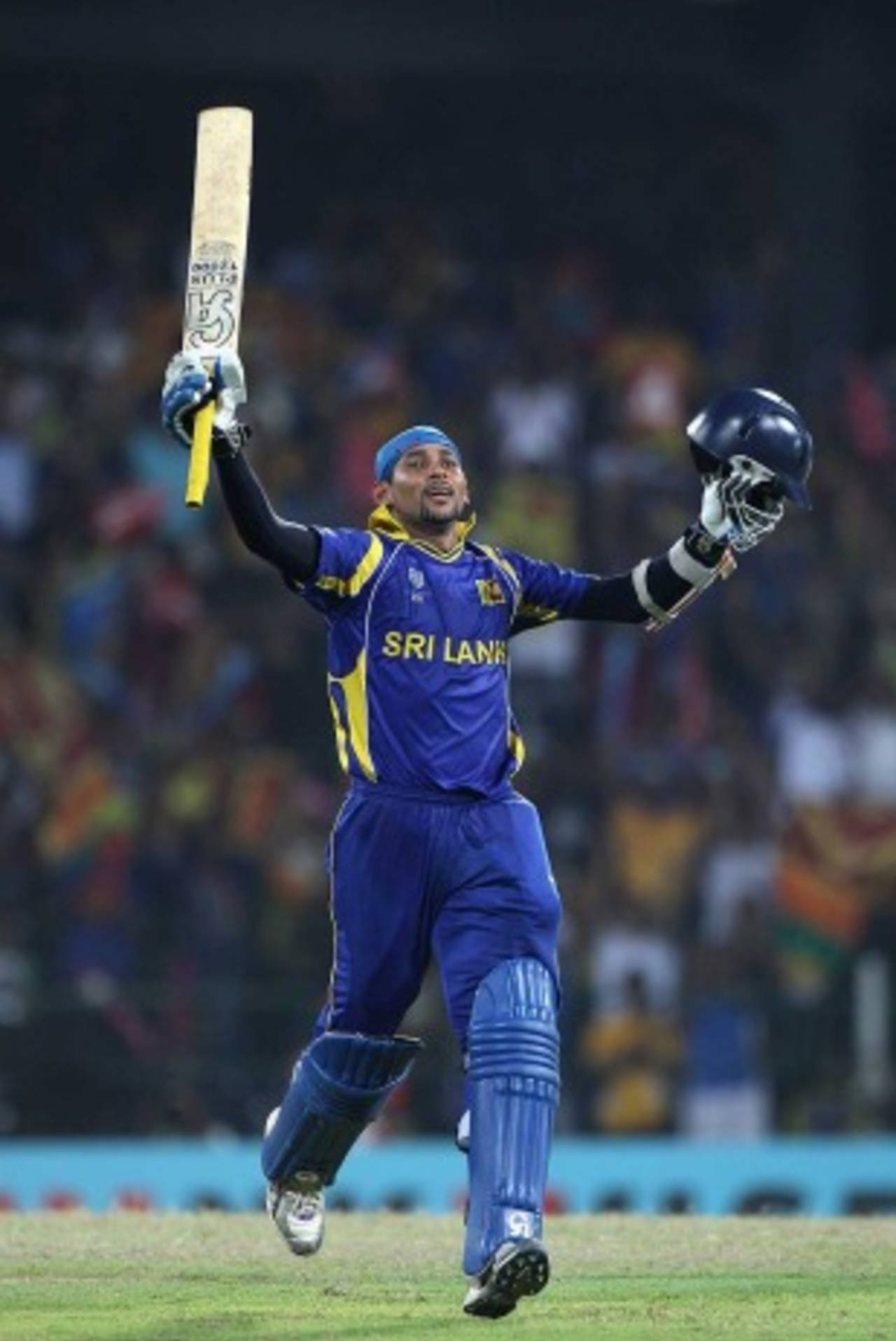Dilshan playing the Jayasuriya role
Scoring runs up front, taking wickets and contributing in the field; Tillakaratne Dilshan's impact in this World cup has been similar to Sanath Jayasuriya's in 1996. And he's had to work harder for his success
Sidharth Monga
31-Mar-2011

Tillakaratne Dilshan saw Sri Lanka home with a century in the quarter-final against England in Colombo • Getty Images
A placard often seen during Sri Lanka games in Sri Lanka says, "Arjuna 1996, Sanga 2011." They may as well draw another one along similar lines: "Sana 1996, Dilshan 2011."
There is one game to go still, but if comparisons were to be drawn with Sri Lanka's great triumph 15 years ago, it would be no disrespect to Sanath Jayasuriya if it were said that Tillakaratne Dilshan, playing some of the most mature cricket of his career, is matching him deed for deed. Jayasuriya in 1996 was all about impact; he was impactful enough to walk away with the Man-of-the-Tournament award for his 221 runs, seven wickets and two Man-of-the Match performances. Numbers don't always tell the story, but here they aren't too far off the mark. Dilshan has already scored 467 runs, taken seven wickets and he came pretty close in the semi-final to securing his third Man-of-the-Match award.
Now, for the story behind the numbers. One of Jayasuriya's special efforts in 1996 was his destruction of England in the Faisalabad quarter-final. Dilshan did much the same this time in Colombo; that after having opened the bowling and taken Andrew Strauss's wicket. When Jayasuriya failed with the bat, he chipped in with the ball. Dilshan has done that too.
For big games, Dilshan's game has come out bigger. In the semi-final, he all but killed New Zealand's spirit with his 73 and Jacob Oram's wicket in his five economical overs. It was tough to keep Jayasuriya out of the game when he fielded, and Dilshan has done even better, making diving saves in the circle in the first half of the innings, and then at the death cutting angles, firing in accurate throws, and keeping one-and-a-halves to ones.
In a way it has been more difficult for Dilshan than it was for Jayasuriya, who had just started to bat the way he did when the 1996 World Cup came around. Dilshan's game has been known to the world for more than two years now. Bowlers are better prepared for Dilshan than they were for Jayasuriya. Bowlers have become smarter too, and the pitches have been tired. Jayasuriya did score over Dilshan in terms of impact, striking at 131 runs per 100 balls as opposed to Dilshan's 93, but this World Cup has been a battle of attrition, and Dilshan has lasted longer than any other opener.
Most importantly, though, while Dilshan has Mahela Jayawardene and Kumar Sangakkara doing what Asanka Gurusinha and Aravinda de Silva used to do, he has none of the buffer that Arjuna Ranatunga, Roshan Mahanama and Hashan Tillakaratne used to provide. That is why Dilshan's sensible batting has been important. Under real pressure against Pakistan in a league game, Sri Lanka's lower-middle order cracked, and almost did a repeat against New Zealand in the semi-final, where a shorter target gave them some elbowroom.
Perhaps that's why, in the quarter-final against England, you could see how badly Dilshan wanted to be there at the end. He cramped up in the second half of that innings, and had to be carried back once the winning runs were scored. Yet not a single injudicious shot was played, no haste was shown. He was almost enjoying the pain. Against New Zealand in the semi-final, he showed remarkable restraint again. It is not an easy game to play for Dilshan, who like Virender Sehwag tends to become restless if boundaries are dried up.
Dilshan is doing a Jayasuriya, a very different version of him: scoring runs, taking wickets, fielding superbly, but is having to work much harder for it. He's also been a bit like his co-finalist Yuvraj Singh, who has single-handedly carried India's middle order and has almost been a full-time bowler too. Going into the finals, you can't look beyond the two if you were looking for the Most Valuable Player.
Not long ago, Dilshan was just a talent going to waste. Over the last two years and more, coinciding with his move to the top of the order, you see him and realise he is a man enjoying what he does. If Prasanna Jayawardene gets injured, he is ready to keep wickets in Tests, and then open the innings. He is never scared of bowling, and doesn't just bowl darts. He is a man who realises he has wasted a bit of time, and is now eager to make the most of what is left of his career.
Twice in two years now, Dilshan has carried Sri Lanka through to a world event's final. He will remember the World Twenty20 in England in 2009. In the final he stumbled, and so did the team. He will also remember the 50-over World Cup final in 2007, where his two overs went for 23 and he was himself run out for 14. The way he has gone in this tournament, Dilshan will give his all to try and make sure there are better events to remember this Saturday by.
Sidharth Monga is an assistant editor at ESPNcricinfo